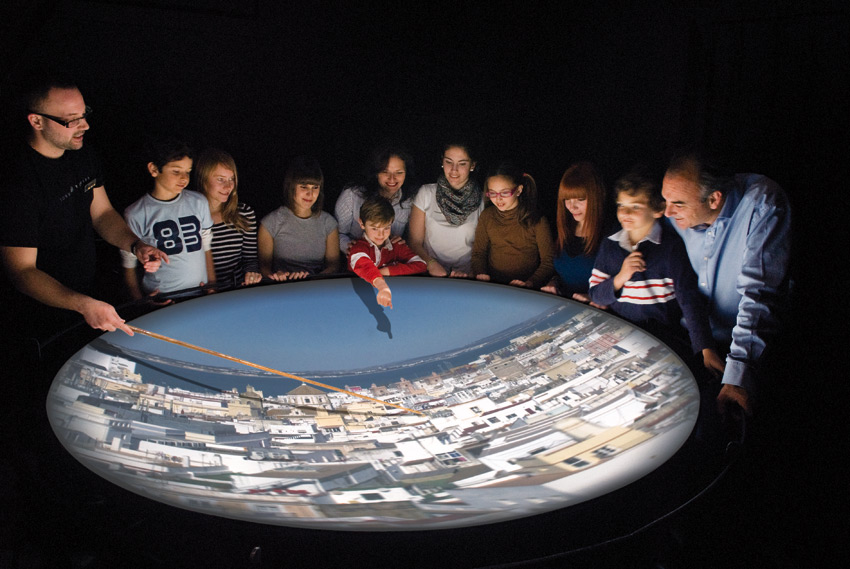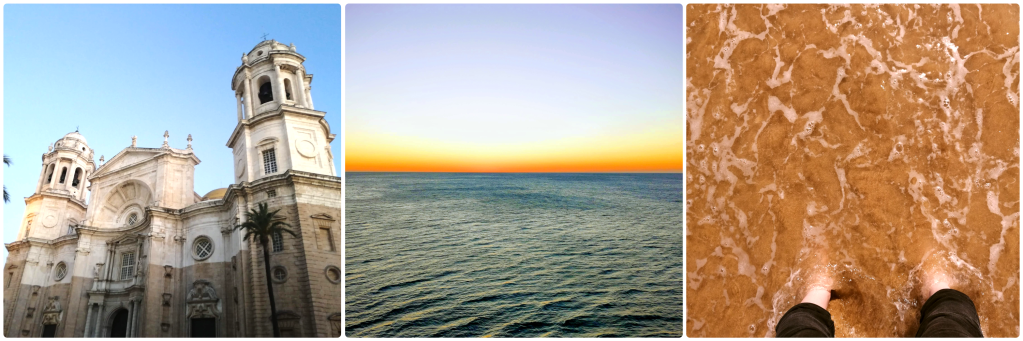When Laurie Lee visited Cadiz, southern Spain in the 1930s, he found it poor, ramshackle, and crime-ridden. He describes it in As I Went Out One Midsummer Morning as ‘a Levantine ghetto … of squat cubist hovels’, too ‘acrid’ to hold him for long.
When Rick Stein made his documentary about the town’s food in 2018, he explored a bustling, beautiful metropolis with world-class seafood and sun-soaked beaches.
My mother, a Rick Stein fiend, and I went there in May 2019 for four nights: Stein, of course, was right, and little remains of Lee’s perception, thanks in large part to the daily cruise ships coming into port.
Although Cadiz (Chhha-deeth, which I didn’t master until at least the third of our four days) is a ship stalwart, it’s not possible to access directly by plane. We instead flew to Jerez (Hereth) and waited 90 minutes for a 90-minute coach to take us the 30km journey.
(My mum and I occupied ourselves by doing the three things we always do when together: we played backgammon in epic, best-of-29 games; we played Scrabble, which I am getting much better at; and we each buried our heads in books).
Chhha-deeth is full of contradiction. It is the oldest city in Europe, but it’s just barely leashed to the Spanish mainland by thin sandy bars constructed in the 1960s. Its entire Old Town is composed of narrow, pedestrianised alleyways with three-storey terraces either side (which are certainly not squat or Cubist), but these open, unexpectedly, onto enormous plazas full of palm trees and light, smooth limestone. There are modern shops and restaurants, as you would expect in any Mediterranean (ish) town, but all the monuments are Gothic, with gargoyles and angels sprouting out of all available patches of space.

There are women everywhere: in bars, in restaurants, at coffee shops, chatting on street corners, shopping: doing everything.
The looming ‘hovels’ are in fact light and high-ceilinged with stone floors and echoing rooms – and in the case of our hotel, had a ridiculous number of plants. My mum had a far nicer room than I did (with an en-suite, urgh) but the upper terrace had an umbrella to keep off the blistering heat and I spent most of my time up there, devouring books when we weren’t sightseeing.

On our first night we ate at a restaurant recommended by Beloved Stein, and on the way, we popped our head round the door of an interesting-looking church on the way. We had been in the church for about thirty seconds when we realised the people involved looked very … organised.
My mum, raised Catholic, was utterly useless at recognising most of the Catholic iconography we encountered, but she worked this out quite quickly. We had wandered into some poor girl’s first communion ceremony. We scarpered pretty quickly.

Something fishy this way comes
One of the things Cadiz has always been most known for (by Lee and Stein) is its fish – shockingly fresh; utterly flavourful; cheap as chips; and plentiful. This was one of the most important bits of the holiday, and we were not going to miss out.
The first thing we visited on our fish expedition was the market, where restaurants actually bought all the fish they were to serve to us. It was immaculately clean, smelt of ice and salt, and the fish looked incredible — if a little terrifying. My mum and I love walking around markets of any description, so we weren’t going to miss this, but it certainly isn’t for everyone.

I bought an oyster for three euros, and it slipped down my throat whole, leaving grit and salt between my teeth.
The fish, once we had it, was incredible. Our first meal was this: dogfish, squid, shrimp, and hake, with delicious potato salad. The batter crunched lightly on our tongue, and the fish itself was as fresh as it comes.

This turned out to be the most delicious meal we had. I had been ludicrously excited about tuna sashimi, as Beloved Stein had informed us that this was the time of year for fresh tuna. However, when it arrived, it was clearly only just defrosted, and I had to order another.

This was what Beloved Stein had recommended most highly, but it fell flat.
Cadiz-ian history
Our first stop was the Museum of Cadiz. As mentioned, it is the oldest city in Europe (a fact that took us both a little by surprise), so we looked politely at pieces of rock from 1000 BC and Greek, Roman, and other miscellaneous remains from all other time periods.


The most interesting pieces were the Roman statues: especially one gentleman who was doing exceptionally well for his age. His more diminutive compatriots did not fare so well, which made my mother think that perhaps he was a replica.

The museum also had an art section — this was more my wheelhouse, especially the works from the Renaissance and around. The works were conserved amazingly well; walking around the vast, blank open space of the galleries punctuated by these bursts of religious adoration, I defy almost anyone not to be moved.




That said, I was almost giddy with stifled laughter when I came to the very end of the exhibition and I saw these. These are modern people, perhaps museum staff, who have attempted to recreate the old paintings using fancy dress and a camera. Their utterly sombre expressions almost did me in.

Big Sister is Watching You
Earnest old men aside, one of the best things to do in the city was the Torre Tavira: the highest tower in the Old Town gives magnificent views across the whole metropolis. But outside the Old Town, there’s lots of construction going on, so cranes are everywhere: the Tower may be old and permanent, but it’s not particularly ground-breaking.
What was ground-breaking, however, was that at the top of this tower is a smaller tower contains a mirror: this is a camera obscura. I’ve never seen one before but they are apparently very common in Britain. Here’s a stock photo, because photography was not allowed:

Camera obscuras (cameras obscura?) work like a periscope, only instead of a viewfinder for one person they project the image onto a huge dish, which a technician raises and lowers, and tilts, to focus it. We were able to see a 360 perspective of the city – zooming in enough to see fluttering washing and people walking up and down the streets. It’s a real-time 360 camera, invented hundreds of years ago.
The attendant had the best job in the world: she spun the ‘camera’ around, zooming in on her own back yard; pointing out the different types of watchtower; taking a small piece of card and ‘picking up’ walking pedestrians or folding the card to make them cross imaginary bridges.
“Remember, if you walk on this street, you are my prey!” she laughed. “Big sister is always watching!”
Lastly there was a cathedral, which looked like this. Forgive me for not being very enthusiastic, but this blog is looking too long as it is. Inside it are were lots of statues of saints and Mary and Big J. It had that wet, wooden smell that old churches always have, and it was unique in having a truly breathtakingly boring audio guide.

Ole!
Despite it being such a big cruise town, there are a number of activities and sites that are mercifully out of day passengers’ scope — this last activity started at 9pm. For the princely sum of twenty-five euros each, we saw a genuine flamenco performance.
Now, I had no idea what flamenco was or why it was so special — I had the cliche in my head of the beautiful, dark-haired woman with a scarlet, frilly dress, curling her wrists and stamping her feet to melodic guitar playing. And real flamenco is… kind of like that, but there’s also so much more to it.
We took our seats at the bar: we were only fifteen minutes early, and the small pub was already crammed with people, including a group of middle-aged Spanish women who drank prodigiously and tried to dance along with little success. The first people to arrive on the small stage were the guitarist and vocalist, and I wasn’t the only person to find their first piece quite strange. The guitarist followed set riffs and patterns, but improvised and side-stepped the traditional patterns beautifully, making emotional facial expressions as he did so. And the vocalist — well, he didn’t so much sing as howl, with his eyes scrunched shut, loudly and emotionally, in a language I couldn’t hope to understand. (It was probably Spanish, but could have been Galician).

After the first piece, which we all applauded a little tentatively, the dancers arrived: two women and a man of preternatural height. They danced together, and then alone, and then together, and then alone. They muttered and chuckled to each other between pieces, and as one was dancing, the others constantly shouted to them. (Whether they were playing characters or just shouting encouragement I don’t know).

The guitarist and vocalist were only a small part of the music: the dancers clapped in varying tempos and volumes as a perfect accompaniment to their music. They seemed to know precisely how loud to clap, when to come in, and when to stop, even though the music appeared to be so heavily improvised. At the end of each piece, all shouted ‘Ole!’ and slapped their thighs.

And the dancing? There was the sexy curling of the wrist — and ankle, and hip — but the main way they expressed themselves was through tap-dancing. The stage floor was already covered in scratches and dents from decades of stomping and sliding, and the noise was deafening.

The dancers’ feet were the top-line of the overall musical pieces, and they were incredible: I have never seen anyone dance so fast, and in such perfect time. Sweat covered their faces and made their hair shine, and their faces stayed solemn as the audience went wild each time they paused, let alone came to the end of a piece. Looking at where the other dancers were looking was the best way to understand the technicality of what was happening: when they looked at their colleague’s faces, or hands, or feet, as they stomped and ran on the spot or flicked their ankles in perfect staccato.
What a way to round off a trip. The only acrid taste Cadiz gave me was the fizzy water in the back of my throat as we walked home. If Laurie Lee could see it now, I wonder what he would say.

Leave a comment